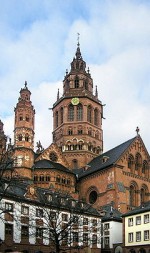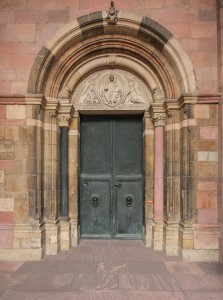C’est probablement peu après sa nomination en 975, que l’archevêque de l’époque, Willigis, décida de la construction d’une nouvelle cathédrale de style ottonien. Elle était destinée à être une cathédrale impériale, symbole architectural d’un empire qui se constituait. Grâce à elle, on devait voir en l’église de Mayence une Seconde Rome. Willigis avait fait construire d’emblée une basilique à colonnes possédant deux chœurs, deux nefs latérales de part et d’autre de la nef centrale et six tours. En forme de croix latine, elle ne possédait encore aucune voûte en raison de sa taille. Le sous-sol marécageux à cause de la proximité du Rhin a provoqué de nombreux problèmes avec les fondations au cours des siècles. Le financement de l’empereur Henri IV eu a une grande importance dans la construction de la cathédrale. L’incendie de 1091 avait alors gravement endommagé l’édifice. Ainsi, vers 1100, Henri IV commença par faire faire des aménagements de la cathédrale en s’inspirant du style lombard. À l’extrémité du chœur est, il fit construire une abside à fausses arcades avec une galerie ( similaire à celle de la cathédrale de Spire, et remplaça la tour d’origine, probablement carrée, par une coupole octogonale. Cette cathédrale suit donc le modèle liturgique romain du Xe siècle avec deux chœurs l’un à l’Est de manière classique l’autre à l’Ouest qui devint la partie la plus importante encore à l’heure actuelle.
It was probably shortly after his appointment in 975 that the then archbishop Willigis decided to build a new cathedral in Ottonian style. It was intended to be an imperial cathedral, an architectural symbol of the emerging empire. The church in Mainz was to be seen as a second Rome. From the outset, Willigis had a columned basilica built with two choirs, two side aisles on either side of the central nave and six towers. The basilica was in the form of a Latin cross, but because of its size, it did not yet have a vault. The marshy subsoil due to the proximity of the Rhine caused many problems with the foundations over the centuries. The financing of Emperor Henry IV was of great importance for the construction of the cathedral. The fire of 1091 had severely damaged the building. So, around 1100, Henry IV began to make alterations to the cathedral based on the Lombard style. At the end of the east choir, he had an apse with false arches and a gallery (similar to that of the cathedral in Speyer) built, and replaced the original tower, which was probably square, with an octagonal dome. The cathedral thus follows the Roman liturgical model of the 10th century with two choirs, one in the east in the classical manner and the other in the west, which is still the most important part today.


